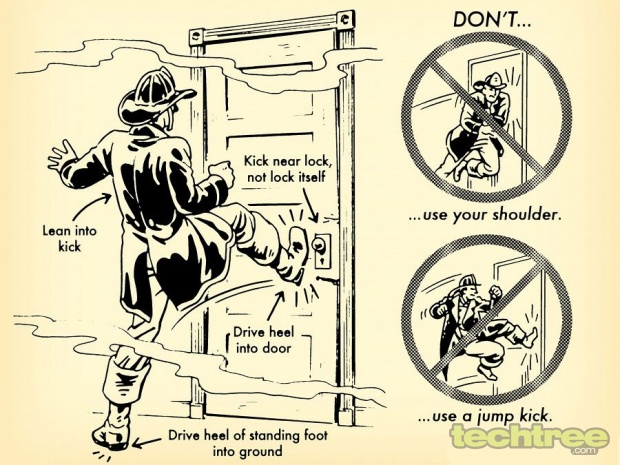-
Nachiket Mhatre
29th Sep 2013
Those who know me by any measure are aware that I chose to be a tech journalist mainly because I couldn't pursue a career in Hollywood. That essentially means I'm neither awfully good looking nor anywhere remotely rich either. So when women reject me—not for these reasons, but—because I ask way too many questions, you know my innate curiosity is a matter of serious concern.
Mind you, my inquisitiveness isn't of Socratic proportions, but it's instead marked by seemingly petty and pointless musings such as:Why is the UPA government hell bent on screwing over the blind?
I mean, why else would the RBI mint coins wherein each denomination is manufactured in every possible permutation and combination of shape, size, pattern, and colour? I'm not exactly blind, and yet it's a Herculean task discerning between these infernally identical coins even for me. In fact, I see no other reason except Manmohan Singh venting his frustration by trolling the poor blind population of the country.What's the mystery behind the seemingly superfluous window on BEST buses?
No, seriously. Why provide a sliding window at the driver's feet? What significant purpose does it achieve that prompts BEST to install it on the entire fleet? The theories explaining its existence have been many; ranging from preventing smelly socks by providing ventilation near the driver's feet, to giving the cops a non-lethal option for disabling a runaway bus by shooting the driver in the foot. However, the true purpose of that window just might remain India's best kept secrets. That is, right after the mystery behind how Bollywood manages to keep on-screen pairings incest-free despite rampant nepotism within its rank and file.
Finally, how the hell did cancer survive [redacted]?
[politician's name removed, because I love my job. And life]
Well, this one's rather self explanatory. The answer is professional courtesy, because they both seem to be the same thing—an uncontrolled corruption. And that means it's no longer a mystery, but I get ahead of myself.
Seriously, what's the point of a window at the driver's foot?
Unfortunately, such insatiable hunger for answers isn't always for the best. Sometimes the ensuing scientific temper tends to raise tempers of a more unpleasant kind. This is especially true when you point out inaccuracies of the kinetic and kinematic variety in daft movies featuring bald beefcakes in supercharged racing cars. You see, the average cinema-goer desperate to escape the cold, hard reality in a theatre doesn't exactly fancy or welcome such candour.
What gets their goat even more is people like me ruining a pointless summer blockbuster by complaining how it's complete and utter bullshit to depict the laughably lanky protagonist decoupling train bogies with consummate ease. The science geek in me sees that the massive tensile stress generated by a running train should make it impossible to pull out the decoupling bolts holding bogies together, but the average Joe just wants to enjoy the movie—science be damned.
Mind you, I genuinely wish to relish such films and videogames. I really do. But the fact that I'm obsessed with military tactics means that I end up walking out of critically acclaimed movies such as the Hurt Locker, simply because the counter-sniper warfare scene is ridiculously inaccurate and childish. As you'll see soon enough, apart from being a science geek, I'm a really petty person to boot. And that means if I can't enjoy my movies and videogames in peace, I'm going to make sure you don't either.
How, you ask? Well, both videogames and films take plenty of artistic liberties when it comes to scientific phenomena—all in the name of creating requisite tension and intrigue to spice up the proceedings, or simply because explaining the real deal would be too long drawn out and boring. That's precisely why we are going to list out the most common myths and, well, debunk them. That way, the next time you watch a movie or play a game, this knowledge will stab away at your psyche until you can't enjoy them anymore. And that's how you'll feel my pain.
Land Mines Won't Detonate Until You Take Your Foot off Them
Just imagine this scene. A crack military squad makes its way through enemy territory, when one of them steps on a landmine. The improvised explosive device obviously won't detonate until the grunt has taken his foot off. If this were a JP Dutta film, this is the part where the doomed soldier promptly lapses into a flashback, where he's shown eating mom-made gajar ka halwa and romancing the heroine in the ancestral mustard field (sarson ka khet) through an eight-minute song and dance sequence replete with six different costume changes.
The Steven Spielberg version would be the same, except for the gajar ka halwa and song and dance routine being replaced with awe-inspiring bugle and sad violin arrangements in the background score. After the rest of the squad and the audience have wiped their tears off, the grunt would ensure his team was out of the blast radius and then step off the land mine to a certain death.
Because Hollywood land mines prefer tension over explosion
While this works as an excellent plot mechanic, it isn't really practical considering that the point of the whole exercise is to kill maximum number of enemies. If the mad scientist who created the land mine really wished to slaughter a lot of people, he sure as hell would have designed it to blow up as soon as the hero stepped on it, and not wait around for the rest of the squad to clear back to safety. If you know how horrific and evil bounding mines are, you can be sure that these mad scientists are sadistic enough to choose the quick kill option.
And that is exactly how real land mines work. You step on one and your body weight sets off a trigger (usually a firing pin or an electronic fuse) that prompts the detonator to ignite the primary explosive after a short delay. The trigger mechanism doesn't care if your foot is on or off the mine, because it will activate the detonator soon after it's supplied with requisite pressure.
That means, the entire premise of the Oscar winning war film No Man's Land is based on a lie. Go figure.
Gun Silencer Attachments are Silent
That's another enduring myth propagated in videogames and Hollywood alike. Silencers aren't remotely silent. Period. In fact, this fabled feat is so unrealistic that those who know their weapons choose not to use the term silencer, but instead refer to the tactical attachment by the correct term—suppressor.
It works pretty much like your regular automotive exhaust muffler. The major sonic component of a gun's report is contributed by expanding propellant gases escaping out the muzzle (end of the barrel). Suppressors work by trapping these gases into multiple baffles or tiny sonic chambers that slow them down and convert the sound energy into heat.
How much of a reduction does that amount to, you ask. Well, the attenuation in decibels is anywhere between 14 to 45 dB depending on various factors that we will get into later. A really good commercially available suppressor will deliver no more than 30 dB of suppression. That's quite impressive considering the decibel scale is logarithmic. Unfortunately, that matters little because a gun report is equally impressive in its loudness.
A silenced gun will still create a bang that's anywhere between 117 (sub-sonic cartridge) to 150 dB (regular cartridge). To put that into perspective, a jackhammer at 50' is measured at 95 dB and a really noisy rock concert is 115 dB, whereas an artillery gun (such as the Bofors howitzer) and turbojet engine clock in at 140 dB and 150 dB respectively. Trust me; that sort of a bang is nevertheless enough to wake up the entire neighbourhood. It most certainly isn't any bit like the muted whimper you hear in videogames and Hollywood flicks.
If that wasn't bad, what's worse is that a suppressor can only deal with noise originating at the muzzle. The sound generated by a weapon's cycling action such as the bolt-carrier assembly—as it uses the propellant gases to eject, feed, and then detonate the cartridge—can be equally loud. The pandu favourite Sterling submachine gun, for example, creates a 115 dB racket just by the virtue of its mechanical action.
Not really silent now, are they?
Furthermore, your standard issue ballistic cartridge is supersonic, which means it breaks the sound barrier shortly after leaving the barrel. The bullet's ensuing transition to supersonic flight tends to create an extremely loud bang known as the ballistic crack. Unless you use specialised sub-sonic ammunition, slapping on a suppressor is as effective as Manmohan Singh at, well, anything for that matter.
This is where you ask, "Wait a minute, then why do suppressors exist?"
Well, they exist because although they don't outright mute a gun's report, they can change the audio signature enough to mask it as a loud everyday sound under right conditions in a noisy environment, of course. Because a suppressor effectively deals with expanding gases at the muzzle, it reduces recoil and thereby increases accuracy and endurance of the shooter. It also provides a significant tactical advantage by vastly reducing muzzle flash, which is a dead giveaway of your position, especially in the dark. Moreover, military snipers deliberately use suppressors with supersonic ammunition. This way, the ballistic crack is heard over the actual muzzle noise, thereby confusing the enemy troops about the shooter's location.
So there you have it. A suppressor doesn't actually exist to reduce the sound of a gun to a whisper, but for more complex military tactics. Does Hollywood care about complex military tactics? No, it doesn't because showing that would turn a war flick into a Discovery Channel documentary. Therefore movies do the next best thing—dumb down an idea to the understanding of the masses and make it an interesting plot element.
To be honest, I don't quite mind this approach despite being a gun geek. That is, as long as it makes the film or videogame interesting. Just imagine playing Metal Gear Solid and Splinter Cell games with realistic depiction of suppressors and you'll know what I mean.
Shoulder Butting Doors Open
This one goes beyond mere videogame/movie myth and can be considered more of health and safety warning. Popular fiction depicts the human shoulder as some sort of an indestructible battering ram that can be used for tackling enemies and breaking in doors alike. The question however is, are our shoulders really that strong?
Well, allow me to cite an example of a friend who thought it was a swell idea to force a door open with her shoulder. As of this writing, she's in pain and unable to make full use of the shoulder she ran into a door—which didn't budge, by the way. This occurred over two months ago. When I asked her why she didn't take a cue from her role model Daya from the cult hit crime series C.I.D., her response was ironically sensible, "Do you really expect me to take life advice from C.I.D.?".
Strangely, where all seemingly serious movies and videogames fail, the most ridiculous of Indian TV series gets it right. The hulking door-disabler Daya actually follows the correct procedure for forcing through locked doors—that is, kicking them in with the foot, as illustrated by the fine gents at The Art of Manliness. Do make it a point to follow their advice, because someday it might save your and/or someone else's life.
And that's how you dislocate the door and not your shoulder
"Fine, I won't run shoulder-first into doors. But what about people I don't agree with? I think it should be perfectly safe to shoulder butt them into compliance, right?"
This is where I'll cite the example of yet another bumbling friend of mine. This athletic, well-built bloke thought it would be a swell idea to pull a Dwayne "The Rock" Johnson on a kabaddi player charging straight at him. A shoulder dislocation and blackout, followed by several repeat episodes of the said dislocation/blackout—punctuated only by two corrective surgeries to fix the damage—is what finally convinced him against using the shoulder for anything except hauling his college bag.
"So are all your friends bumbling idiots?"
Now, there's no need to be mean. Next question.
"But wait! Surrounded by the mighty deltoid muscle, the shoulder is one of the largest, most well-articulated joints in the human body. It surely can't be as weak as you make it out to be."
And that's why you should pay attention in biology class, kids. You see, the strength of a joint is inversely proportional to the range of articulation offered. In layman's terms, greater the joint's range of motion, lower is its strength. That's one of the reasons why the complicated ankle and wrist joints that rotate along two separate axes are considerably weaker than the elbow and knee joints that rotate about a single axis. The shoulder sports an amazing degree of articulation unlike any other joint in the body.
To achieve this, it cannot employ the sturdy ball-and-socket design of the stronger joints such as the elbow or the knee. It instead uses a laughably shallow excuse of a ball-and-socket assembly, which provides greater freedom of motion as a trade off. However, this makes it so weak that it requires a whole set of muscles (dubbed as the rotator-cuff muscles) to hold it into place. It's little wonder why the fragile shoulder stands no chance against a door.
Any significant impact to it simply rips the delicate muscles and tendons off the joint with consummate ease. So the next time you're tempted to use your shoulder to make a dramatic entry into a locked room, take a deep breath and try to visualise the tendons and ligaments tearing apart and triggering an excruciating amount of pain and suffering that lasts for months on end. That should make you reconsider.
Using Vehicles and Furniture as Cover
Walk into a room full of baddies in any videogame or movie and you'll find them upending the nearest tables and using them as seemingly perfect bulletproof shields. What's more, apart from providing excellent lumbar support and a comfortable TV viewing position, your average sofa set also seems to posses excellent resistance to bullets. So the next time bad guys come knocking at your door, would it be a good idea take cover behind household furniture?
You can run, but you can't hide. Behind a car, that is.
To understand why that's utter and complete bullshit, allow me to introduce you to the Springfield M1 Garand rifle. A primary weapon of the US armed forces in World War II, it fired a .30-06 (7.62x63 mm) cartridge at a muzzle velocity of 2800 ft/s. If that sounded Sanskrit and Bhojpuri to you, all you need to know is that this round could punch a hole through a tree trunk and continue onwards through the Nazi scum cowering behind it. Even a regular pistol cartridge such as the ubiquitous 9x19 Parabellum round (1400 ft/s) has enough kinetic energy to punch through any common household furniture.
What about vehicles, then? They're made from metal, so one would assume that should offer good protection. That would be an incorrect assumption because bullets don't really behave that way. Contrary to conventional wisdom, ballistic rounds can pass easily through denser obstacles such as metal or wood than through a more fluid rich medium such as human tissue. This has more to do with the inability of fluids to be compressed, thus causing the devastating hydrostatic effect that wreaks havoc on both tissue as well as the bullet.
Scientific mumbo jumbo aside, this means even a lowly pistol round will have absolutely no issue passing through both car doors simultaneously. The only thing dense enough to offer any iota of protection is the engine block and the wheel wells. Those too can be penetrated by anti-matter rounds such as the .50 BMG cartridge, fired through rifles such as the Barrett M107 or other alternatives sporting that calibre. Heck, even a single-brick wall will not hold up for long against rifle rounds. The writing is on the wall, so to speak: don't take cover, just shut up and shoot back at the bad guys.
So there you have it, four of the most enduring movie/videogame myths busted, as promised. There are plenty more examples that make it harder to suspend ones disbelief. However, just like films and games, that's something left for a sequel. Unfortunately, this also means you're now all set to become this guy at the cinema.
Common Videogame and Movie Myths Busted | TechTree.com
Common Videogame and Movie Myths Busted
They call it show business for a reason.
News Corner
- DRIFE Begins Operations in Namma Bengaluru
- Sevenaire launches ‘NEPTUNE’ – 24W Portable Speaker with RGB LED Lights
- Inbase launches ‘Urban Q1 Pro’ TWS Earbuds with Smart Touch control in India
- Airtel announces Rs 6000 cashback on purchase of smartphones from leading brands
- 78% of Indians are saving to spend during the festive season and 72% will splurge on gadgets & electronics
- 5 Tips For Buying A TV This Festive Season
- Facebook launches its largest creator education program in India
- 5 educational tech toys for young and aspiring engineers
- Mid-range smartphones emerge as customer favourites this festive season, reveals Amazon survey
- COLORFUL Launches Onebot M24A1 AIO PC for Professionals







TECHTREE